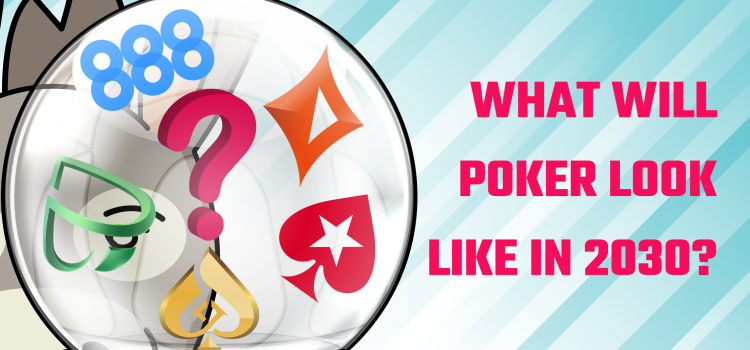What Will Poker Look Like in the Future?
Predictions about the poker industry for the next ten years.
 Predicting the future, so the sages tell us, is a mug’s game. The world is full of aborted trends, sudden reversals, and black swans which make fools of soothsayers and economists.Mug’s game or not, it is always fun to to look forward to the new decade. So let’s play anyway.Never Start A Land War In AsiaOne of the biggest shifts in the 2010s was the slow crackdown by western governments on online poker. While I expect a lot of this legislation will be repealed or rewritten by 2030, the biggest change will be the opening up of the Indian and Chinese markets.Both nations have a rich cultural history of gambling and both have a large pool of gamblers who have started taking an interest in poker has their game of choice. They also happen to be the two most populous countries in the world, one in three people alive today is Chinese or Indian.India is further along in the legalisation process. At least one Indian state allows poker games to be played on grounds that they are “skill based” games rather than games of change, and Goa has allowed offshore casinos to function for years. Online poker is technically illegal in India but websites go largely unmolested by the law.China is a different kettle of fish. To anyone familiar with Macau’s reputation it might come as a surprise that mainland China prohibits online gambling. There are ways around this though for the bolder citizens and plenty of websites, such as PPPoker and Red Dragon Poker, now service the Chinese market from offshore centres.The Chinese government would do well to realise this toothpaste is out of the tube.When In China…When the Chinese government fully legalise online poker. It is going to revolutionise the way the game is played.The world of online poker is very different for Chinese players. Chinese sites, like PokerBros, our use something similar to the Macau junket system with games being set up with smaller hand-picked groups of people numbering a few hundred similar to the “home games” offered by Pokerstars.I suspect as the majority of players start to come from websites that work this way, the bigger Western sites will adapt and junket style play will become the norm online and off.The Robots Are ComingLast decade we watched as Pluribus, Carnegie Mellon University’s pet poker AI, beat some of the biggest names in poker. It beat Darren Elias and Chris “Jesus” Ferguson heads up of 5,000 games and then hammered a bunch of pros in a six-max game over another 10,000.So far Pluribus is not yet scaleable or cheap enough for Pluribus to be playing online yet.That is going to change.Pluribus isn’t the only Roboplayer in the game. Google’s AlphaGO beat the best player in the world at go, a game in which most people assumed a computer would never be able to surpass the best humans.Google says AlphaGO is an all purpose learning machine. It has been adapted to make their own server banks more efficient and they hope to teach it to negotiation international treaties.Someone’s gonna see the pile of money sitting at the poker table in the next ten years and when they do, AlphaGO is going to be fed the rules of poker. The clock is ticking. Pure PokerSince Chris Moneymaker won the WSOP in 2003, signed a deal with PartyPoker and kickstarted the poker revolution, the game has been getting tougher and tougher. Where online games were once a sea of clueless fish, now even the most inept players know how to play a tight-aggressive game and to calculate pot odds.Everyone is a grinder now.This increase in difficulty has frozen out a lot of new players. But it has also prompted a proliferation of smaller sites, like Run It Once, that are purging poker of heads-up displays, hand histories, and other tools of the serious pro. By cutting down on the number of sharks and blunting their edge these sites are making the game more appealing and much closer to the world of brick and mortar games.I suspect that rooms like this will fare well in the next ten years. Softer games will attract new players which should balance out the relatively small number of sharks that will leave their gizmos behind to hunt their prey the old fashioned way.Don’t Mess With TexasAfter 2003, everyone started playing no limit Texas Holdem. But in the early 20th Century the big game was five card draw and five card stud, during World War 2 everyone was playing seven card stud, in Europe the tendency was to play pot limit and in the States the games were all fixed or spread limit. No limit games of Texas Holdem were for specialists only.The other variants of poker all but disappeared after 2003. But last year the WSOP coverage included plenty of non-holdem games, and since 2015 the highest stakes games on our streams have been million euro buy-in short deck games.At the time of writing Pokerstars advertises 20 game variants, that can all be played as limit, pot limit, or no limit as well as various stakes, table sizes, and tournament formats.By 2030 Holdem will no longer be the default game.2030 in ReviewI am sure the next ten years will hold a whole lot more which none of us will have seen coming. But I feel pretty confident that by 2030 we’ll be looking at a poker world in which mixed games will push out NLH, South and East Asian players will be main customer base, and most players will move towards homegame and junket-style games.In the purely online realm, the online poker landscape will have been completely changed by the need to combat online bots and will have been made more streamlined and newbie friendly.Let’s meet back here in ten years to see if I was right. By Jon Pill
Predicting the future, so the sages tell us, is a mug’s game. The world is full of aborted trends, sudden reversals, and black swans which make fools of soothsayers and economists.Mug’s game or not, it is always fun to to look forward to the new decade. So let’s play anyway.Never Start A Land War In AsiaOne of the biggest shifts in the 2010s was the slow crackdown by western governments on online poker. While I expect a lot of this legislation will be repealed or rewritten by 2030, the biggest change will be the opening up of the Indian and Chinese markets.Both nations have a rich cultural history of gambling and both have a large pool of gamblers who have started taking an interest in poker has their game of choice. They also happen to be the two most populous countries in the world, one in three people alive today is Chinese or Indian.India is further along in the legalisation process. At least one Indian state allows poker games to be played on grounds that they are “skill based” games rather than games of change, and Goa has allowed offshore casinos to function for years. Online poker is technically illegal in India but websites go largely unmolested by the law.China is a different kettle of fish. To anyone familiar with Macau’s reputation it might come as a surprise that mainland China prohibits online gambling. There are ways around this though for the bolder citizens and plenty of websites, such as PPPoker and Red Dragon Poker, now service the Chinese market from offshore centres.The Chinese government would do well to realise this toothpaste is out of the tube.When In China…When the Chinese government fully legalise online poker. It is going to revolutionise the way the game is played.The world of online poker is very different for Chinese players. Chinese sites, like PokerBros, our use something similar to the Macau junket system with games being set up with smaller hand-picked groups of people numbering a few hundred similar to the “home games” offered by Pokerstars.I suspect as the majority of players start to come from websites that work this way, the bigger Western sites will adapt and junket style play will become the norm online and off.The Robots Are ComingLast decade we watched as Pluribus, Carnegie Mellon University’s pet poker AI, beat some of the biggest names in poker. It beat Darren Elias and Chris “Jesus” Ferguson heads up of 5,000 games and then hammered a bunch of pros in a six-max game over another 10,000.So far Pluribus is not yet scaleable or cheap enough for Pluribus to be playing online yet.That is going to change.Pluribus isn’t the only Roboplayer in the game. Google’s AlphaGO beat the best player in the world at go, a game in which most people assumed a computer would never be able to surpass the best humans.Google says AlphaGO is an all purpose learning machine. It has been adapted to make their own server banks more efficient and they hope to teach it to negotiation international treaties.Someone’s gonna see the pile of money sitting at the poker table in the next ten years and when they do, AlphaGO is going to be fed the rules of poker. The clock is ticking. Pure PokerSince Chris Moneymaker won the WSOP in 2003, signed a deal with PartyPoker and kickstarted the poker revolution, the game has been getting tougher and tougher. Where online games were once a sea of clueless fish, now even the most inept players know how to play a tight-aggressive game and to calculate pot odds.Everyone is a grinder now.This increase in difficulty has frozen out a lot of new players. But it has also prompted a proliferation of smaller sites, like Run It Once, that are purging poker of heads-up displays, hand histories, and other tools of the serious pro. By cutting down on the number of sharks and blunting their edge these sites are making the game more appealing and much closer to the world of brick and mortar games.I suspect that rooms like this will fare well in the next ten years. Softer games will attract new players which should balance out the relatively small number of sharks that will leave their gizmos behind to hunt their prey the old fashioned way.Don’t Mess With TexasAfter 2003, everyone started playing no limit Texas Holdem. But in the early 20th Century the big game was five card draw and five card stud, during World War 2 everyone was playing seven card stud, in Europe the tendency was to play pot limit and in the States the games were all fixed or spread limit. No limit games of Texas Holdem were for specialists only.The other variants of poker all but disappeared after 2003. But last year the WSOP coverage included plenty of non-holdem games, and since 2015 the highest stakes games on our streams have been million euro buy-in short deck games.At the time of writing Pokerstars advertises 20 game variants, that can all be played as limit, pot limit, or no limit as well as various stakes, table sizes, and tournament formats.By 2030 Holdem will no longer be the default game.2030 in ReviewI am sure the next ten years will hold a whole lot more which none of us will have seen coming. But I feel pretty confident that by 2030 we’ll be looking at a poker world in which mixed games will push out NLH, South and East Asian players will be main customer base, and most players will move towards homegame and junket-style games.In the purely online realm, the online poker landscape will have been completely changed by the need to combat online bots and will have been made more streamlined and newbie friendly.Let’s meet back here in ten years to see if I was right. By Jon Pill
Poker rooms

BetKings
- Rakeback up to 60%
- Deposit bonus 600$

PokerKing
- Rakeback up to 65%
- Deposit bonus 1000$

CoinPoker
- Rakeback Contact us
- Deposit bonus 2000$

Tiger Gaming
- Rakeback Contact us
- Deposit bonus 1000$

WPT Global
- Rakeback up to 45%
- Deposit bonus 1200$
New challenge

Thank God!
Show us an excellent example of that one time when you were incredibly lucky and "THANK GOD!" gave your opponent the bad beat he deserves!
Recent blog & news
888poker BLAST turns $1 into $1,000,000 prize
Since Winamax introduced lottery-style Sit and Go games with their groundbreaking Espresso format at the time, interest in these games has only grown. Following suit,...
Millionaire prize won at Winamax Jackpot for €1 buy-in
A player named "Bastuguee" has just won a €1 million jackpot prize in an Expresso poker table at Winamax poker. The game had a €1 buy-in and the odds of the event are...
Winamax May Come to Portugal Soon
The biggest French online poker room, Winamax, has recently launched a webpage with a Portugal domain and a message "coming soon". The page is now offline as...